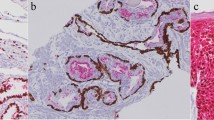Abstract
Background
The differences in features and risk factors for recurrence after definitive surgical excision are yet to be determined. The aim of this study was to understand these factors influencing recurrence patterns with local and regional disease in these patients.
Methods
A total of 365 relapsed patients, of whom 196 presented with local disease (stage I–II) and 169 with regional disease (stage III), were investigated in this retrospective study.
Results
The median time to initial recurrence for stage I–II and stage III patients was 22.3 and 13.4 months, respectively. Stage III patients were found to have higher Clark levels (p = 0.0001) and thicker lesions (p = 0.0001), and they were more significantly associated with the absence of tumor-infiltrating lymphocytes (p = 0.02) than stage I–II patients. Stage III patients were more significantly associated with recurrences compared to the stage I–II patients (p = 0.0001). Locoregional relapses were significantly associated with stage I–II melanomas, whereas majority of the distant metastases occurred in stage III patients (p = 0.01). Pulmonary metastasis was most frequently observed and the distribution of the sites for distant metastases was similar in both groups of the patients. On univariate analysis, male sex, increased tumor depth, presence of ulceration, nodular histopathology, higher Clark level, higher mitotic rate, and presence of lymphovascular invasions were found to predict shorter time to relapse for stage I–II patients; whereas only nodular pathology, presence of ulceration, and high mitotic rate were found to be associated with poor relapse-free survival in stage III patients. However, on multivariate analysis, only mitotic rate maintained its significance for both clinical staging groups.
Conclusion
Potential differences among early-stage melanoma patients, who developed recurrence, were noted and mitotic rate was found as the single significant prognostic factor for recurrence in both stage I–II and III patients.

Similar content being viewed by others
References
Siegel RL, Miller KD, Jemal A. Cancer statistics, 2017. CA Cancer J Clin. 2017;67:7–30.
Soong SJ, Harrison RA, McCarthy WH, Urist MM, Balch CM. Factors affecting survival following local, regional, or distant recurrence from localized melanoma. J Surg Oncol. 1998;67:228–33.
Tas F. Metastatic behavior in melanoma: timing, pattern, survival, and influencing factors. J Oncol 2012; Volume 2012, Article ID 647684.
Tas F, Erturk K. Recurrence behavior in early-stage cutaneous melanoma: pattern, timing, survival and influencing factors. Melanoma Res. 2017;27:134–9.
Meier F, Will S, Ellwanger U, Schlagenhauff B, Schittek B, Rassner G, Garbe C. Metastatic pathways and time courses in the orderly progression of cutaneous melanoma. Br J Dermatol. 2002;147:62–70.
Tejera-Vaquerizo A, Barrera-Vigo MV, Fernández-Canedo I, Blázquez-Sánchez N, Mendiola-Fernández M, Fernández-Orland A, et al. Longitudinal study of different metastatic patterns in the progression of cutaneous melanoma. Acta Dermosifiliogr. 2007;98:531–8.
Marcoval J, Ferreres JR, Martín C, Gómez S, Penín RM, Ochoa de Olza M, et al. Patterns of visceral metastasis in cutaneous melanoma: a descriptive study. Acta Dermosifiliogr. 2013;104:593–7.
Lee AY, Droppelmann N, Panageas KS, Zhou Q, Ariyan CE, Brady MS, et al. Patterns and timing of initial relapse in pathologic stage II melanoma patients. Ann Surg Oncol. 2017;24:939–46.
Romano E, Scordo M, Dusza SW, Ciot DG, Chapman PB. Site and timing of first relapse in stage III melanoma patients: implications for follow-up guidelines. J Clin Oncol. 2010;28:3042–7.
Thompson JF, Soong SJ, Balch CM, Gershenwald JE, Ding S, Coit DG, et al. Prognostic significance of mitotic rate in localized primary cutaneous melanoma: an analysis of patients in the multi-institutional American Joint Committee on Cancer melanoma staging database. J Clin Oncol. 2011;29:2199–205.
Donizy P, Kaczorowski M, Leskiewicz M, Zietek M, Pieniazek M, Kozyra C, et al. Mitotic rate is a more reliable unfavorable prognosticator than ulceration for early cutaneous melanoma: a 5-year survival analysis. Oncol Rep. 2014;32:2735–43.
Azzola MF, Shaw HM, Thompson JF, Soong SJ, Scolyer RA, Watson GF, et al. Tumor mitotic rate is a more powerful prognostic indicator than ulceration in patients with primary cutaneous melanoma: an analysis of 3661 patients from a single center. Cancer. 2003;97:1488–98.
Hale CS, Qian M, Ma MW, Scanlon P, Berman RS, Shapiro RL, et al. Mitotic rate in melanoma: prognostic value of immunostaining and computer-assisted image analysis. Am J Surg Pathol. 2013;37:882–9.
Gershenwald JE, Scolyer RA, Hess KR, Sondak VK, Long GV, Ross MI, et al. Melanoma staging: evidence-based changes in the American Joint Committee on Cancer eighth edition cancer staging manual. CA Cancer J Clin. 2017;67:472–92.
Keung EZ, Balch CM, Gershenwald JE, Halpern AC. Key changes in the AJCC eighth edition melanoma staging system. Melanoma Lett. 2017;36(1):1–9.
Author information
Authors and Affiliations
Corresponding author
Ethics declarations
Conflict of interest
The authors declare that they have no conflicts of interest.
Ethical approval
All procedures performed in this study involving human participants were in accordance with the ethical standards of the institutional and/or national research committee and with the 1964 Helsinki Declaration and its later amendments or comparable ethical standards. The study was reviewed and approved by our local ethical committee.
Informed consent
Informed consent was obtained from all individual participants included in the study.
Rights and permissions
About this article
Cite this article
Tas, F., Erturk, K. Relapse patterns in patients with local and regional cutaneous melanoma. Clin Transl Oncol 21, 412–419 (2019). https://doi.org/10.1007/s12094-018-1938-9
Received:
Accepted:
Published:
Issue Date:
DOI: https://doi.org/10.1007/s12094-018-1938-9




